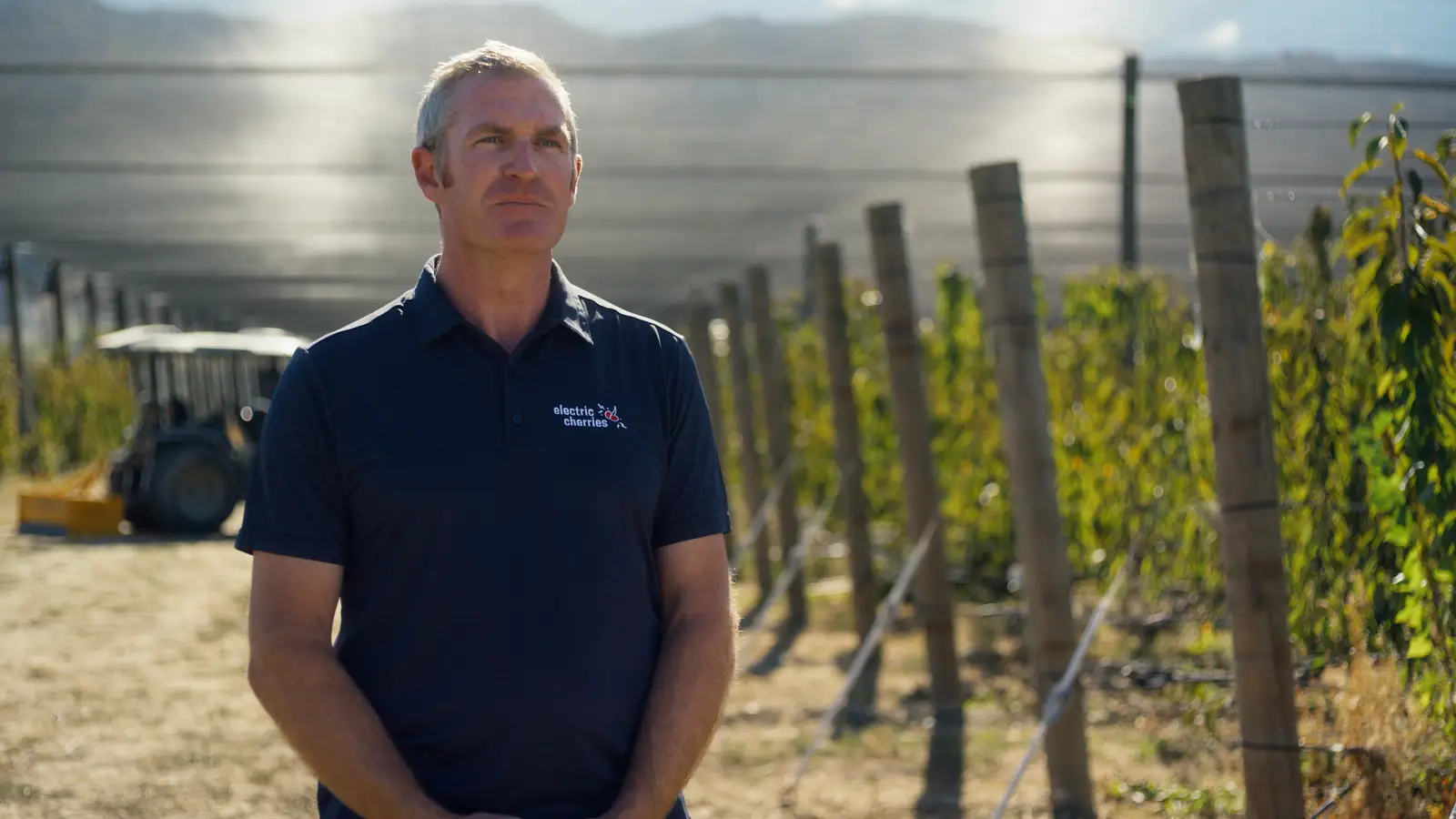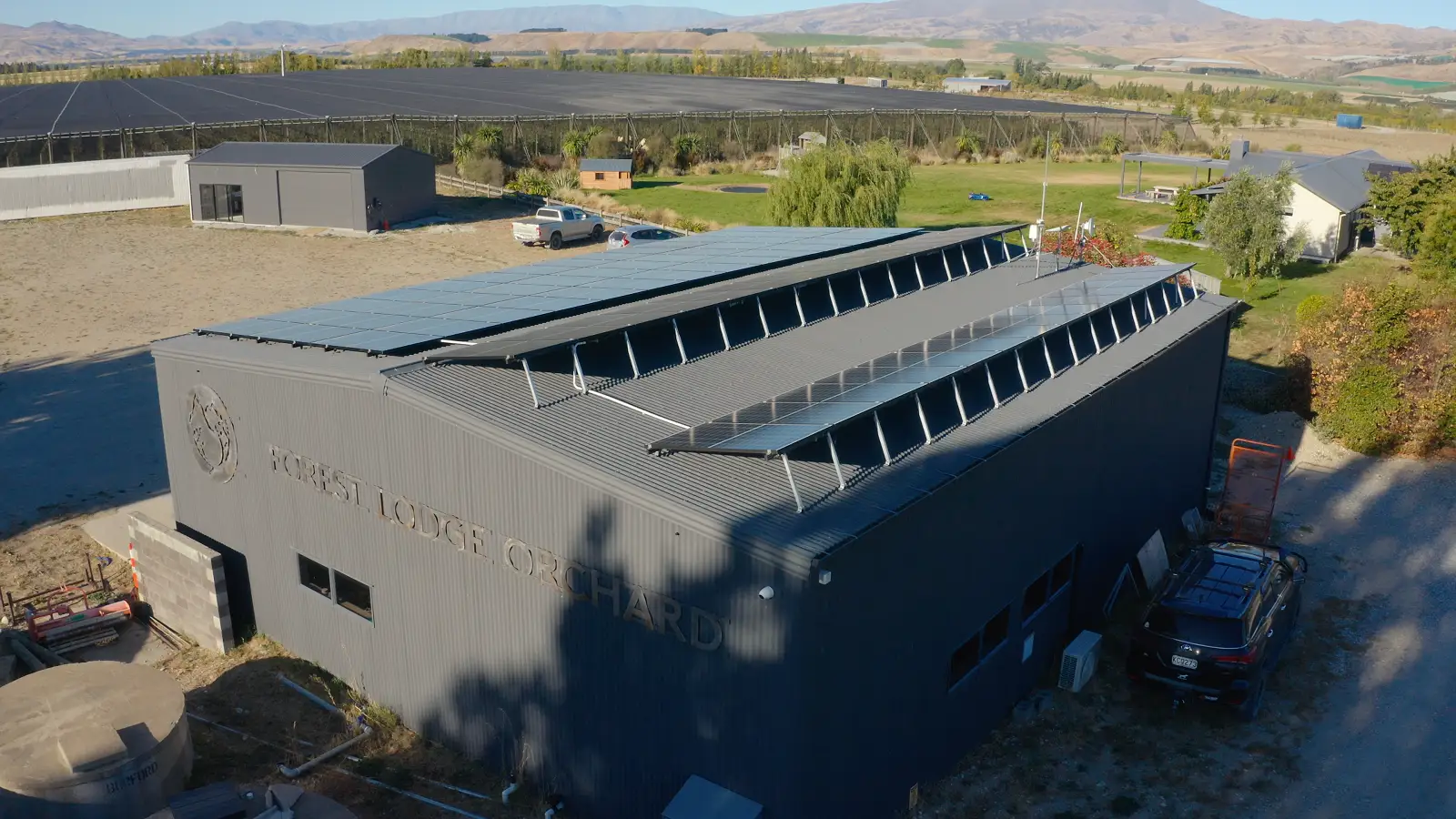Central Otago cherry orchard Forest Lodge is the world’s first fully electrified, fossil-fuel-free commercial orchard. Read about how the 6-hectare operation has replaced all diesel-dependent machinery and infrastructure with electric alternatives powered by a grid-connected solar photovoltaic (PV) and battery system.
The orchard's energy infrastructure
| Orchard size: | 6 hectares of cherries |
| Power system: | 160 kW solar + 300 kWh on-site lithium-ion storage |
| Grid connection: | Maintained for peak-load support and export revenue |
| Energy profile: | Produces 2x annual energy needs |
| Fuels used: | 100% electric – no petrol or diesel |
| Savings: | Over $40,000 saved annually on energy and fuel costs |
The system architecture enables simultaneous operation of high-draw equipment including irrigation pumps, frost-fighting fans, electric tractors, and harvesting vehicles. The grid connection remains essential for redundancy during high-demand events like overnight frost fighting, while excess solar is exported during off-peak periods to generate extra income.

A sun-powered system
Forest Lodge hasn’t just adopted solar technology — the team has built an entire farming operation around it. The transformation started not with ambition, but necessity.
“We had a diesel water pump explode in our first season,” says Euan White, orchard manager and co-owner. “That kicked off a chain reaction — if we’re going electric, let’s power it with solar. If we’ve got solar, let’s store the energy. From there, it just snowballed.”
From the start the orchard was designed with energy efficiency and more electrification in mind, giving the team a unique opportunity to size the solar system for total seasonal demand.
“Most farms retrofit solar to run their cool store or offset irrigation. We said… what if solar could do everything?”
The orchard runs a 160 kW solar PV system paired with 300 kWh of battery storage. It’s the beating heart of their operation, fueling:
- Orchard management — Fully electric 40 hp tractor (driver-optional), electric mowers, and platforms.
- Irrigation — Electric pumps powered directly by solar during daytime.
- Frost protection — Two electric frost fans with peak draw supported by grid.
- On the move — Electric transport vehicles, forklifts, and trucks.
- In the shed — Lighting, monitoring, and visitor services all grid-independent during daylight hours.
Each component was selected or retrofitted to ensure compatibility with 100% electric operation.

The benefits of solar on farm
The financial and operational returns have been significant — with the running costs for key farming operations plummeting.
One example is the orchard’s approach to frost fighting, a fairly energy-intensive task in Central Otago. “Our electric frost fans cost about $1 an hour to run,” White says. “Compare that to $150-$200 per hour for diesel versions — it’s not even close.”
This single change saves tens of thousands of dollars annually, while also eliminating the logistical headache of transporting and storing diesel.
The entire farm's irrigation system - previously a major fuel sink — is now virtually free to operate. Forest Lodge produces twice the electricity they use annually. This means excess energy is exported back to the grid, generating an additional revenue stream. “We irrigate when it’s hot and sunny,” says White. “Exactly when the solar panels are pumping out power. It just makes so much sense.”
Add in reduced maintenance — an electric golf cart has cost less than $100 in five years — and the ability to charge many vehicles from standard wall sockets, and the return on investment becomes clear.
Reliability and farm resilience
The orchard still connects to the grid, not for everyday supply, but as a safety net during long periods of poor solar generation or high overnight use.
White says the team get asked a lot about whether such a setup is viable in real-world, time-critical farming. Can a fully electric orchard actually keep up with the demands of a growing season?
“We’ve never had a situation where power wasn’t available when we needed it,” White says. “Even on frosty nights, the grid gives us backup, and the battery buffers short-term peaks.”
White says even frost-fighting fans, which draw significant energy, are supported by a mix of solar, battery, and grid supply. That grid tie-in is crucial, not just as a backup, but also as a way to export surplus energy at high rates - a long-term financial asset.
“We designed for resilience. If the battery’s low or the sun’s not shining, the grid is there. But 95% of the time, we’re using our own solar power.”
Future farming
Forest Lodge co-founder Mike Casey says the orchard’s solar set up not just as a technical achievement — it was also about setting the farm up for the future.
“We’re in a remote location. Getting diesel deliveries in winter isn’t guaranteed. Plus, we know carbon costs are only going one way. Electrification is a long-term hedge.”
“We’re not special growers,” Casey says. “We follow the same techniques. What’s different is how we power everything.”
And it’s a scalable vision. The infrastructure they’ve implemented — solar panels, batteries, electric vehicles — is becoming more accessible and cost-effective each year.
“You don’t need to start with everything we have,” says White. “Start with a wall socket and one EV. Get the bug. Scale up.”
“We've proven that everything a traditional orchard can do, we can do better — with less noise, and lower costs,” White says. “We have never lacked power availability for any critical operation.”
Lessons for growers considering solar
- Plan for growth — Electrification increases demand.
- Size your system for peak operations — Consider including panels for frost fighting, charging, and vehicle use.
- Batteries help, but grid support is still valuable — The grid gives you flexibility and resilience but most of your power can still come from your own panels.
- Start with irrigation — It's the easiest and most impactful load to electrify using solar directly.
- Electric equipment is ready — Tractors, mowers, and carts are all commercially available now.
Looking ahead
Forest Lodge’s model is now drawing attention from across the sector — and beyond.
“We get calls from other growers every week,” says White. “They’re not just asking if it works. They’re asking how soon they can do it.”
“This isn’t a moonshot. We’re just a cherry orchard in Otago showing what’s possible with what’s already out there. And it’s working.”
Read next
-
Solar on farms
Information, tools and support to help farmers install solar panels on farms in New Zealand.
- Innovation
- Solar energy
-
From sunlight to savings
A 54 kw solar PV system is paying off for this Wairarapa dairy farm.
- Case study
- Solar energy
-
Targeted spraying with drone technology
How an electric drone sprayer has helped Felton Road Wines reduce its diesel use and transform its vineyard management.
- Case study
- Innovation
- Solar energy


